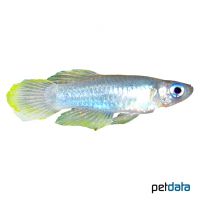Norman's Lampeye (Poropanchax normani)
| Norman's Lampeye Poropanchax normani | |
|---|---|
| Name | Norman's Lampeye |
| Name Lat. | Poropanchax normani |
| Synonym | Aplocheilichthys normani |
| Family | African Lampeyes |
| Family lat. | Procatopodidae |
| Order | Killifishes & Livebearers |
| Order lat. | Cyprinodontiformes |
| Origin | Western Africa |
| Habitat | Savanna streams |
| Diet | Carnivore |
| pH | 6.5-7.5 |
| Behavior | Peaceful |
| Keeping | Group |
| Care Level | Moderate |
| Reproduction | Substrate spawner |
| Breeding | Moderately difficult |
| Life Span | 2-3 years |
| Protection | No |
| Metric Units | |
| Size | 4 cm |
| Temperature | 22-26 °C |
| Hardness | 5-12 °dH |
| Aquarium | ~ 80 l |
| US Units | |
| Size | 1.6" |
| Temperature | 72-79 °F |
| Hardness | 89-214 ppm |
| Aquarium | ~ 20 gal |
Distribution and habitat
The Norman's Luminous Eyefish are widely distributed in western Africa, from Senegal through Nigeria and Cameroon to the Central African Republic. They live in the small, plant- and oxygen-rich rivers and streams of the savannas.
Maintenance
The aquarium should have a varied, partly dense marginal planting and provide sufficient swimming space. A dark substrate, shaded light (floating plants) and a moderate current is ideal.
No ammonia, ammonium and nitrite should be detectable, and the nitrate value should not exceed 100 mg/l. To ensure the water quality and oxygen content, a filter and heater adapted to the aquarium size is required, as well as lighting for the species-appropriate day-night rhythm of the animals.
Diet
In nature they feed mainly on small insects on the water surface, insect larvae and plankton. The food supply consists of live, frozen and dry food. For a balanced diet, feed once a day with a high-quality, protein-rich dry food (flakes, granules, micropellets) and with cyclops, moina, daphnia, artemia, mosquito larvae, fruit flies, fruit flies, etc. (live or frozen)
It is recommended to feed small portions several times a day. Only feed as much as will be eaten within a few minutes. A regular and varied diet promotes health and increases resistance.
Behaviour and compatibility
They are peaceful and shy fish and should be kept in a group or in a small school (approx. 10 animals). They can be well socialized with other calm and not too large fish. Males occasionally engage in harmless power struggles among themselves (courtship). Basically, only compatible fish species with similar demands on water quality and water temperature may be socialized.
Sex dimorphism
Males have slightly more extended fins and are more intensely colored than females.
Reproduction and breeding
They are substrate spawners that do not practice brood care. The eggs with adhesive filaments are spawned over fine-leaved plants (java moss). The fry hatch after 10-12 days and swim, wriggling eel-like, at the water surface in the current
Fry must be fed several times a day with special rearing food (infusoria, Artemia nauplii). In community tanks breeding is hardly possible, because the spawn is easy prey.
Important
The food is gladly taken from the water surface. They are good jumpers, accordingly, the aquarium must be well covered
The well-being of the fish should be checked regularly. The temperature should be checked daily, the pH, hardness and nitrate value at least every 14 days. Regular partial water changes are recommended, even if the contaminant level has not yet reached the upper limit. Sudden changes in water quality should be avoided. Newly introduced fish must be accustomed slowly to the water in the aquarium.
Further literature can be found in your pet store.
References
Text: Werner Winter; Image: petdata
Source: BMELV (1998): Tierschutzgutachten - Haltung von Zierfischen (Süßwasser); BAENSCH & RIEHL (2004): Aquarien Atlas Bd. 3, Mergus Verlag; RADDA & PÜRZL (1982): Killifische aus aller Welt, Band 2, Verlag Otto Hoffmann; ENGELMANN (2005): Zootierhaltung - Tiere in menschlicher Obhut: Fische, Verlag Harri Deutsch
- Gemäß § 21 Abs. 5 Tierschutzgesetz idgF
